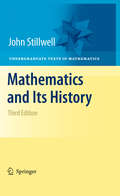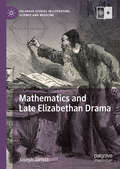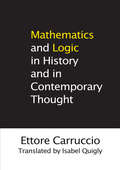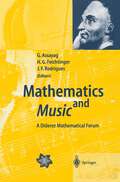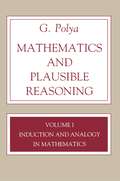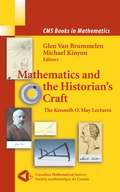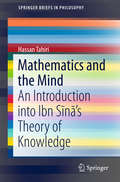- Table View
- List View
Mathematics and Its Applications: A Transcendental-Idealist Perspective (Synthese Library #385)
by Jairo José da SilvaThis monograph offers a fresh perspective on the applicability of mathematics in science. It explores what mathematics must be so that its applications to the empirical world do not constitute a mystery. In the process, readers are presented with a new version of mathematical structuralism.The author details a philosophy of mathematics in which the problem of its applicability, particularly in physics, in all its forms can be explained and justified. Chapters cover: mathematics as a formal science, mathematical ontology: what does it mean to exist, mathematical structures: what are they and how do we know them, how different layers of mathematical structuring relate to each other and to perceptual structures, and how to use mathematics to find out how the world is.The book simultaneously develops along two lines, both inspired and enlightened by Edmund Husserl’s phenomenological philosophy. One line leads to the establishment of a particular version of mathematical structuralism, free of “naturalist” and empiricist bias. The other leads to a logical-epistemological explanation and justification of the applicability of mathematics carried out within a unique structuralist perspective. This second line points to the “unreasonable” effectiveness of mathematics in physics as a means of representation, a tool, and a source of not always logically justified but useful and effective heuristic strategies.
Mathematics and Its History (Undergraduate Texts in Mathematics)
by John StillwellThis book offers a collection of historical essays detailing a large variety of mathematical disciplines and issues; it’s accessible to a broad audience. This second edition includes new chapters on Chinese and Indian number theory, on hypercomplex numbers, and on algebraic number theory. Many more exercises have been added as well as commentary that helps place the exercises in context.
Mathematics and Its History (Undergraduate Texts in Mathematics)
by John StillwellFrom a review of the second edition:"This book covers many interesting topics not usually covered in a present day undergraduate course, as well as certain basic topics such as the development of the calculus and the solution of polynomial equations. The fact that the topics are introduced in their historical contexts will enable students to better appreciate and understand the mathematical ideas involved...If one constructs a list of topics central to a history course, then they would closely resemble those chosen here."(David Parrott, Australian Mathematical Society)This book offers a collection of historical essays detailing a large variety of mathematical disciplines and issues; it’s accessible to a broad audience. This third edition includes new chapters on simple groups and new sections on alternating groups and the Poincare conjecture. Many more exercises have been added as well as commentary that helps place the exercises in context.
Mathematics and Its History (Undergraduate Texts in Mathematics)
by John StillwellA concise, unified view of mathematics together with its historical development. Aiming at mathematicians who have mastered the basic topics but wish to gain a better grasp of mathematics as a whole, the author gives the reasons for the emergence of the main fields of modern mathematics, and explains the connections between them by tracing the course of a few mathematical themes from ancient times down to the 20th century. The emphasis here is on history as a method for unifying and motivating mathematics, rather than as an end in itself, and there is more mathematical detail than in other general histories. However, no historical expertise is assumed, and classical mathematics is rephrased in modern terms where needed. Nevertheless, there are copious references to original sources for readers wishing to explore the classics for themselves. In summary, readers will be able to add to their mathematical knowledge as well as gaining a new perspective on what they already know.
Mathematics and Its History: A Concise Edition (Undergraduate Texts in Mathematics)
by John StillwellThis textbook provides a unified and concise exploration of undergraduate mathematics by approaching the subject through its history. Readers will discover the rich tapestry of ideas behind familiar topics from the undergraduate curriculum, such as calculus, algebra, topology, and more. Featuring historical episodes ranging from the Ancient Greeks to Fermat and Descartes, this volume offers a glimpse into the broader context in which these ideas developed, revealing unexpected connections that make this ideal for a senior capstone course. The presentation of previous versions has been refined by omitting the less mainstream topics and inserting new connecting material, allowing instructors to cover the book in a one-semester course. This condensed edition prioritizes succinctness and cohesiveness, and there is a greater emphasis on visual clarity, featuring full color images and high quality 3D models. As in previous editions, a wide array of mathematical topics are covered, from geometry to computation; however, biographical sketches have been omitted. Mathematics and Its History: A Concise Edition is an essential resource for courses or reading programs on the history of mathematics. Knowledge of basic calculus, algebra, geometry, topology, and set theory is assumed. From reviews of previous editions: “Mathematics and Its History is a joy to read. The writing is clear, concise and inviting. The style is very different from a traditional text. I found myself picking it up to read at the expense of my usual late evening thriller or detective novel…. The author has done a wonderful job of tying together the dominant themes of undergraduate mathematics.” Richard J. Wilders, MAA, on the Third Edition"The book...is presented in a lively style without unnecessary detail. It is very stimulating and will be appreciated not only by students. Much attention is paid to problems and to the development of mathematics before the end of the nineteenth century.... This book brings to the non-specialist interested in mathematics many interesting results. It can be recommended for seminars and will be enjoyed by the broad mathematical community." European Mathematical Society, on the Second Edition
Mathematics and Late Elizabethan Drama (Palgrave Studies in Literature, Science and Medicine)
by Joseph JarrettThis book considers the influence that sixteenth-century and early seventeenth-century mathematical thinking exerted on the writing and production of popular drama between about 1587 and 1603. It concentrates upon six plays by five early modern dramatists: Tamburlaine, Part 1 (1587) and Tamburlaine, Part 2 (1587) by Christopher Marlowe; Friar Bacon and Friar Bungay (1589) by Robert Greene; Old Fortunatus (1599) by Thomas Dekker; Hamlet (1600) by William Shakespeare; and The Tragedy of Hoffman (1603) by Henry Chettle. Each chapter analyses how the terms, concepts, and implications of contemporary mathematics impacted upon these plays’ vocabularies, forms, and aesthetic and dramaturgical effects and affects.
Mathematics and Logic in History and in Contemporary Thought
by Isabel Quigly Ettore CarruccioThis book is not a conventional history of mathematics as such, a museum of documents and scientific curiosities. Instead, it identifies this vital science with the thought of those who constructed it and in its relation to the changing cultural context in which it evolved. Particular emphasis is placed on the philosophic and logical systems, from Aristotle onward, that provide the basis for the fusion of mathematics and logic in contemporary thought.
Mathematics and Logic in History and in Contemporary Thought
by Isabel Quigly Ettore CarruccioThis book is not a conventional history of mathematics as such, a museum of documents and scientific curiosities. Instead, it identifies this vital science with the thought of those who constructed it and in its relation to the changing cultural context in which it evolved. Particular emphasis is placed on the philosophic and logical systems, from Aristotle onward, that provide the basis for the fusion of mathematics and logic in contemporary thought.
Mathematics and Music: A Diderot Mathematical Forum
by Gerard Assayag Hans G. FeichtingerIn Western Civilization Mathematics and Music have a long and interesting history in common, with several interactions, traditionally associated with the name of Pythagoras but also with a significant number of other mathematicians, like Leibniz, for instance. Mathematical models can be found for almost all levels of musical activities from composition to sound production by traditional instruments or by digital means. Modern music theory has been incorporating more and more mathematical content during the last decades. This book offers a journey into recent work relating music and mathematics. It contains a large variety of articles, covering the historical aspects, the influence of logic and mathematical thought in composition, perception and understanding of music and the computational aspects of musical sound processing. The authors illustrate the rich and deep interactions that exist between Mathematics and Music.
Mathematics and Philosophy 2: Graphs, Orders, Infinites and Philosophy
by Daniel ParrochiaFrom Pythagoreans to Hegel, and beyond, this book gives a brief overview of the history of the notion of graphs and introduces the main concepts of graph theory in order to apply them to philosophy. In addition, this book presents how philosophers can use various mathematical notions of order. Throughout the book, philosophical operations and concepts are defined through examining questions relating the two kinds of known infinities – discrete and continuous – and how Woodin's approach can influence elements of philosophy. We also examine how mathematics can help a philosopher to discover the elements of stability which will help to build an image of the world, even if various approaches (for example, negative theology) generally cannot be valid. Finally, we briefly consider the possibilities of weakening formal thought represented by fuzziness and neutrosophic graphs. In a nutshell, this book expresses the importance of graphs when representing ideas and communicating them clearly with others.
Mathematics and Plausible Reasoning, Volume 1: Induction and Analogy in Mathematics
by G. PolyaA guide to the practical art of plausible reasoning, this book has relevance in every field of intellectual activity. Professor Polya, a world-famous mathematician from Stanford University, uses mathematics to show how hunches and guesses play an important part in even the most rigorously deductive science. He explains how solutions to problems can be guessed at; good guessing is often more important than rigorous deduction in finding correct solutions. Vol. I, on Induction and Analogy in Mathematics, covers a wide variety of mathematical problems, revealing the trains of thought that lead to solutions, pointing out false bypaths, discussing techniques of searching for proofs. Problems and examples challenge curiosity, judgment, and power of invention.
Mathematics and Plausible Reasoning, Volume 1: Induction and Analogy in Mathematics
by G. PolyaA guide to the practical art of plausible reasoning, this book has relevance in every field of intellectual activity. Professor Polya, a world-famous mathematician from Stanford University, uses mathematics to show how hunches and guesses play an important part in even the most rigorously deductive science. He explains how solutions to problems can be guessed at; good guessing is often more important than rigorous deduction in finding correct solutions. Vol. I, on Induction and Analogy in Mathematics, covers a wide variety of mathematical problems, revealing the trains of thought that lead to solutions, pointing out false bypaths, discussing techniques of searching for proofs. Problems and examples challenge curiosity, judgment, and power of invention.
Mathematics and Plausible Reasoning, Volume 2: Logic, Symbolic and mathematical
by G. PolyaA guide to the practical art of plausible reasoning, this book has relevance in every field of intellectual activity. Professor Polya, a world-famous mathematician from Stanford University, uses mathematics to show how hunches and guesses play an important part in even the most rigorously deductive science. He explains how solutions to problems can be guessed at; good guessing is often more important than rigorous deduction in finding correct solutions. Vol. II, on Patterns of Plausible Inference, attempts to develop a logic of plausibility. What makes some evidence stronger and some weaker? How does one seek evidence that will make a suspected truth more probable? These questions involve philosophy and psychology as well as mathematics.
Mathematics and Scientific Representation (Oxford Studies in Philosophy of Science)
by Christopher PincockMathematics plays a central role in much of contemporary science, but philosophers have struggled to understand what this role is or how significant it might be for mathematics and science. In this book Christopher Pincock tackles this perennial question in a new way by asking how mathematics contributes to the success of our best scientific representations. In the first part of the book this question is posed and sharpened using a proposal for how we can determine the content of a scientific representation. Several different sorts of contributions from mathematics are then articulated. Pincock argues that each contribution can be understood as broadly epistemic, so that what mathematics ultimately contributes to science is best connected with our scientific knowledge. In the second part of the book, Pincock critically evaluates alternative approaches to the role of mathematics in science. These include the potential benefits for scientific discovery and scientific explanation. A major focus of this part of the book is the indispensability argument for mathematical platonism. Using the results of part one, Pincock argues that this argument can at best support a weak form of realism about the truth-value of the statements of mathematics. The book concludes with a chapter on pure mathematics and the remaining options for making sense of its interpretation and epistemology. Thoroughly grounded in case studies drawn from scientific practice, this book aims to bring together current debates in both the philosophy of mathematics and the philosophy of science and to demonstrate the philosophical importance of applications of mathematics.
Mathematics and the Craft of Thought in the Anglo-Dutch Renaissance (Routledge Studies in Renaissance and Early Modern Worlds of Knowledge)
by Eleanor ChanThe development of a coherent, cohesive visual system of mathematics brought about a seminal shift in approaches towards abstract thinking in western Europe. Vernacular translations of Euclid’s Elements made these new and developing approaches available to a far broader readership than had previously been possible. Scholarship has explored the way that the language of mathematics leaked into the literary cultures of England and the Low Countries, but until now the role of visual metaphors of making and shaping in the establishment of mathematics as a practical tool has gone unexplored. Mathematics and the Craft of Thought sheds light on the remarkable culture shift surrounding the vernacular language translations of Euclid, and the geometrical imaginary that they sought to create. It shows how the visual language of early modern European geometry was constructed by borrowing and quoting from contemporary visual culture. The verbal and visual language of this form of mathematics, far from being simply immaterial, was designed to tantalize with material connotations. This book argues that, in a very real sense, practical geometry in this period was built out of craft metaphors.
Mathematics and the Craft of Thought in the Anglo-Dutch Renaissance (Routledge Studies in Renaissance and Early Modern Worlds of Knowledge)
by Eleanor ChanThe development of a coherent, cohesive visual system of mathematics brought about a seminal shift in approaches towards abstract thinking in western Europe. Vernacular translations of Euclid’s Elements made these new and developing approaches available to a far broader readership than had previously been possible. Scholarship has explored the way that the language of mathematics leaked into the literary cultures of England and the Low Countries, but until now the role of visual metaphors of making and shaping in the establishment of mathematics as a practical tool has gone unexplored. Mathematics and the Craft of Thought sheds light on the remarkable culture shift surrounding the vernacular language translations of Euclid, and the geometrical imaginary that they sought to create. It shows how the visual language of early modern European geometry was constructed by borrowing and quoting from contemporary visual culture. The verbal and visual language of this form of mathematics, far from being simply immaterial, was designed to tantalize with material connotations. This book argues that, in a very real sense, practical geometry in this period was built out of craft metaphors.
Mathematics and the Historian's Craft: The Kenneth O. May Lectures (CMS Books in Mathematics)
by Michael Kinyon Glen Van BrummelenThe Kenneth May Lectures have never before been published in book form Important contributions to the history of mathematics by well-known historians of science Should appeal to a wide audience due to its subject area and accessibility
Mathematics and the Mind: An Introduction into Ibn Sīnā’s Theory of Knowledge (SpringerBriefs in Philosophy)
by Hassan TahiriThis book examines how epistemology was reinvented by Ibn Sīnā, an influential philosopher-scientist of the classical Islamic world who was known to the West by the Latinised name Avicenna. It explains his theory of knowledge in which intentionality acts as an interaction between the mind and the world. This, in turn, led Ibn Sīnā to distinguish an operation of intentionality specific to the generation of numbers.The author argues that Ibn Sīnā’s transformation of philosophy is one of the major stages in the de-hellinisation movement of the Greek heritage that was set off by the advent of the Arabic-Islamic civilisation. Readers first learn about Ibn Sīnā’s unprecedented investigation into the concept of the number and his criticism of such Greek thought as Plato’s realism, Pythagoreans’ empiricism, and Aristotle’s conception of existence. Next, coverage sets out the basics of Ibn Sīnā’s theory of knowledge needed for the construction of numbers. It describes how intentionality turns out to be key in showing the ontological dependence of numbers as well as even more critical to their construction. In describing the various mental operations that make mathematical objects intentional entities, Ibn Sīnā developed powerful arguments and subtle analyses to show us the extent our mental life depends on intentionality. This monograph thoroughly explores the epistemic dimension of this concept, which, the author believes, can also explain the actual genesis and evolution of mathematics by the human mind.
Mathematics and the Roots of Postmodern Thought
by Vladimir TasicThis is a charming and insightful contribution to an understanding of the "Science Wars" between postmodernist humanism and science, driving toward a resolution of the mutual misunderstanding that has driven the controversy. It traces the root of postmodern theory to a debate on the foundations of mathematics early in the 20th century, then compares developments in mathematics to what took place in the arts and humanities, discussing issues as diverse as literary theory, arts, and artificial intelligence. This is a straightforward, easily understood presentation of what can be difficult theoretical concepts It demonstrates that a pattern of misreading mathematics can be seen both on the part of science and on the part of postmodern thinking. This is a humorous, playful yet deeply serious look at the intellectual foundations of mathematics for those in the humanities and the perfect critical introduction to the bases of modernism and postmodernism for those in the sciences.
Mathematics and the Roots of Postmodern Thought
by Vladimir TasicThis is a charming and insightful contribution to an understanding of the "Science Wars" between postmodernist humanism and science, driving toward a resolution of the mutual misunderstanding that has driven the controversy. It traces the root of postmodern theory to a debate on the foundations of mathematics early in the 20th century, then compares developments in mathematics to what took place in the arts and humanities, discussing issues as diverse as literary theory, arts, and artificial intelligence. This is a straightforward, easily understood presentation of what can be difficult theoretical concepts It demonstrates that a pattern of misreading mathematics can be seen both on the part of science and on the part of postmodern thinking. This is a humorous, playful yet deeply serious look at the intellectual foundations of mathematics for those in the humanities and the perfect critical introduction to the bases of modernism and postmodernism for those in the sciences.
Mathematics and War
by Bernhelm Booß-Bavnbek Jens HøyrupMathematics has for centuries been stimulated, financed and credited by military purposes. Some mathematical thoughts and mathematical technology have also been vital in war. During World War II mathematical work by the Anti-Hitler coalition was part of an aspiration to serve humanity and not help destroy it. At present, it is not an easy task to view the bellicose potentials of mathematics in a proper perspective. The book presents historical evidence and recent changes in the interaction between mathematics and the military. It discusses the new mathematically enhanced development of military technology which seems to have changed the very character of modern warfare.
Mathematics as a Tool: Tracing New Roles of Mathematics in the Sciences (Boston Studies in the Philosophy and History of Science #327)
by Johannes Lenhard Martin CarrierThis book puts forward a new role for mathematics in the natural sciences. In the traditional understanding, a strong viewpoint is advocated, on the one hand, according to which mathematics is used for truthfully expressing laws of nature and thus for rendering the rational structure of the world. In a weaker understanding, many deny that these fundamental laws are of an essentially mathematical character, and suggest that mathematics is merely a convenient tool for systematizing observational knowledge. The position developed in this volume combines features of both the strong and the weak viewpoint. In accordance with the former, mathematics is assigned an active and even shaping role in the sciences, but at the same time, employing mathematics as a tool is taken to be independent from the possible mathematical structure of the objects under consideration. Hence the tool perspective is contextual rather than ontological. Furthermore, tool-use has to respect conditions like suitability, efficacy, optimality, and others. There is a spectrum of means that will normally differ in how well they serve particular purposes. The tool perspective underlines the inevitably provisional validity of mathematics: any tool can be adjusted, improved, or lose its adequacy upon changing practical conditions.
A Mathematics Course for Political and Social Research (PDF)
by Will H. Moore David A. SiegelPolitical science and sociology increasingly rely on mathematical modeling and sophisticated data analysis, and many graduate programs in these fields now require students to take a "math camp" or a semester-long or yearlong course to acquire the necessary skills. Available textbooks are written for mathematics or economics majors, and fail to convey to students of political science and sociology the reasons for learning often-abstract mathematical concepts. A Mathematics Course for Political and Social Research fills this gap, providing both a primer for math novices in the social sciences and a handy reference for seasoned researchers. The book begins with the fundamental building blocks of mathematics and basic algebra, then goes on to cover essential subjects such as calculus in one and more than one variable, including optimization, constrained optimization, and implicit functions; linear algebra, including Markov chains and eigenvectors; and probability. It describes the intermediate steps most other textbooks leave out, features numerous exercises throughout, and grounds all concepts by illustrating their use and importance in political science and sociology. Uniquely designed and ideal for students and researchers in political science and sociology Uses practical examples from political science and sociology Features "Why Do I Care?" sections that explain why concepts are useful Includes numerous exercises Complete online solutions manual (available only to professors, email david.siegel at duke.edu, subject line "Solution Set") Selected solutions available online to students
Mathematics, Education and History: Towards a Harmonious Partnership (ICME-13 Monographs)
by Kathleen M. Clark Tinne Hoff Kjeldsen Sebastian Schorcht Constantinos TzanakisThis book includes 18 peer-reviewed papers from nine countries, originally presented in a shorter form at TSG 25 The Role of History of Mathematics in Mathematics Education, as part of ICME-13 during. It also features an introductory chapter, by its co-editors, on the structure and main points of the book with an outline of recent developments in exploring the role of history and epistemology in mathematics education. It serves as a valuable contribution in this domain, by making reports on recent developments in this field available to the international educational community, with a special focus on relevant research results since 2000. The 18 chapters of the book are divided into five interrelated parts that underlie the central issues of research in this domain: 1. Theoretical and conceptual frameworks for integrating history and epistemology in mathematics in mathematics education; 2. Courses and didactical material: Design, implementation and evaluation; 3. Empirical investigations on implementing history and epistemology in mathematics education; 4. Original historical sources in teaching and learning of and about mathematics; 5. History and epistemology of mathematics: Interdisciplinary teaching and sociocultural aspects. This book covers all levels of education, from primary school to tertiary education, with a particular focus on teacher education. Additionally, each chapter refers to and/or is based on empirical research, in order to support, illuminate, clarify and evaluate key issues, main questions, and conjectured theses raised by the authors or in the literature on the basis of historical-epistemological or didactical-cognitive arguments.


